#The Welsh nightingale
Explore tagged Tumblr posts
Text

EDITH WYNNE. The subject of our present pencilling was born at Holywell. She made her debut, as a soprano of no ordinary promise, at the great National Eisteddvod held at Llangollen in 1858. Those who had the good foitune to be at the elithusiastic meetings of that glorious gathering will never forget the sunny little girl in Welsh costume who sang "Clycbau Aberdovey" as she plied her tiny, wee, stock-knitting the while. How she did pour out her very soul in song to be sure, as her clear, silvery notes came flying out of her lips, and went careering around the roof of the spacious pavilion-as if a flight of nightingales was" migrating from earth to btaven It was while that' little girl was retiring, amid a storm of applause, after singing "Aderyo Pur" that tho gentleman seated beside the writer first broke silence. Verre goot," said he, magnifique par Dieu; one grand song. I undeltake one great travel, route entiere from Italy, for to hear this style of du Welsh Shant, and that one song has made repay ali mine expenses." The promising young sungtress of the Llugollen Eisteddvod of 1858 again reappears before her countrymeu upon the platfurm of the Mold Eisteddvod in 1873. But how changed during the interval ! The aspirant for musical fame of 1858 returns in 1873 as a soprano of world-wide celobrity-as a Cantatrke whom the denizens of two Hemispheres have flocked to hear and to applaud. She returns decked with triumphs. But of all the proud wreaths which adorn her brow, the fairest is this-she has never forgotten her native land. Edith Wynne.. has not:—nor its dear old melodies, They were the first companiono of her earlier struggles -the witfie«ses and the assistants of her first triumphs, those old Welsh songs were. There may or there may not be hidden in the inmost recesses of the great Songstress's escritoire some old pebble, or withered heather, or faded flower bud-embleni of this sad or that speiny memury-theie may, or there may not. But the unfinished sock is assuredly there and the knitting needles and just a scrap of an old MS. song, with Un, dati, tri"-(pedwar, worn uut). pump. ckwech-meddai Clychau Aurdovey."No, Edith Wynne has not forgotten her Welsh songs. She still sings her national melodies, with the expression and pronunciation of a native. She never astonishes the Aboriginta with such form of the Welsh words of Aderyn Pur" as the following, which was given at a Penny Keadiug, in the writer's hearing, by a young lady from Liechwedd y Llidiardau, who had been once to Manchester, and twice, by an excursion train, to Birkenhead. Now, the eharw of Edith Wynne's Welsh singing is its correct enunciation. London has not made her forget her Welsh.She can enunciate it as currcctly now as when sbe hrst left her native hills. Not only can, but does; and to say that is to say a good deal. Because it cannot be but that long residence in England, and continued practice in other tongues should, as it dots, mar one's readiness iu an unused foim of speech. But not in Wales only is our heroine a star of whom any people and any land may be proud. A concert or a festival in Loudon or in the English provinces would soarcely be held to te complete,the programme which did cointain the ever welcome and honoured name of Edith Wynne.And whether she sings before Royalty,at a National Eisteddfod own people, she is always the same popular, unaffected, patriotic, honest, "open spirit. Wales has in the presellt day many sons; and daughters of whom she can well atiord to be pruder, but of no one is she prouder than of this chief of song, who casts a lustre alike upou herself aud upon her people by the proud positiou which she holds amoug the" very first of contemporary musical celebrities.—
***
Edith Wynne came from a musical family in North Wales, and sho was one of the many famous artistes whose genius was first discovered by Llew Llwyfo, the versatile Welsh bard and musician. Llew heard the future prima donna when she was in her 14th year. This was in an eisteddfod in the neighbourhood of Wrexham, at which Llew was adjudicating. The purity and richness of her voice at once attracted the attention of Llew, and it was mainly at his urgent request that Miss ynne's family were persuaded to train her for a musical career. Having studied for some years at Liverpool, she proceeded to Italy, and at Florence placed herself under the tuition of Romani, and afterwards studied with Signor Vauncini. Her first appearance before a London audience was in 1862, at a concert given by Mr. John Thomas, the Queen's harpist, at which Thalbcrg and the great Jenny Lind were present, and both predicted for her a bright career. She soon established for herself an enviable reputation as a soprano vocalist, and secured triumph after triumph in various parts of the kingdom. In 1871, accompanied by the late Madame Patey, Mr. Santley, and Mr. W. H. Cummings, the present president of the (.uildhall* School of Music, she toured in the United States, and repeated the visit in 1874, when she appeared in Boston at the Handel and Haydn triennial festival. Upon her return she was presented by her countrymen and country- women with a marble bust of herself and a diamond bracelet, the presentation taking place at a concert given by the London Welsh Choral Union. The bust was handed to her by Col. Coruwallis-West, the present Lord-Lieutenant of Denbighshire, and the bracelet—which had on it her eisteddfodic iiom tie pin nit, "Eos Cymru" (The Nightingale of Wales), set in large brilliants—was formally presented to her by the great Sir Watkin, the "Prince in Wales." Edith Wynne, in her day, saug at all the great festivals of the kingdom except that of Worcester, and has on repeated occasions sung at State concerts at Buckingham Palace with Madame Christine Nilsson, Madame Albani, and the late famous contralto, Alboni. Madame Edith Wynne had a brief experience of the stage, for in 1864 she played Lady Mortimer in Henry IV. at Drury-lane for eight weeks. She used to sing each night "Clychau Aberdovey" in Welsh; and on one occasion al a party given at his house shortly belore his death, Charles Dickens remarked to her Miss Wynne, I shall never forget the pleasure you gave me in hearing you sing in Henry the Fourth.' In 1875 she was married at the Chapel Royal, Savoy, to Mr. Aviet Agabeg, an Armenian gentleman who enjoys a lucrative practice as one of the leaders of the Rangoon bar. Madame Agubeg resided in England to superintend the education of her daughter, their only child, who, according to Mr. Frederic (irimths in his Notable Welsh Musicians" gives great prominence of having inherited her mother's talent.
#classical music#opera#music history#bel canto#composer#classical composer#aria#classical studies#maestro#chest voice#Sarah Edith Wynne#Eos Cymru#The Nightingale of Wales#The Nightingale#soprano#classical muscian#classical musicians#classical history#opera history#history of music#history#historian of music#musician#musicians#diva#prima donna#Edith Wynne#The Welsh nightingale
2 notes
·
View notes
Text
I was blabbing abt brit actors over dinner bc I was happy Michael Sheen appeared in my Pinterest feed after a while and my grandma recognized him as the great actor he is so I started googling this and that trying to find in which movie did she saw him and now I've added Good Omens, The Witcher and The secret of Mary Reilly in our watch list, (there's a perfectly logical connection between all of this) and now I've decida that:
1 - I'm gonna watch Granada Holmes bc I'm insane and I absolutely have free time between Doctor Who and Supernatural and
2 - now I want a Sherlock adaptation w David Tennant and Michael Sheen as Sherlock and John in their late cases, maybe the hound of the Baskervilles??? or a series w the short stories. But actually if it were a 10 min short w them chatting over tea and looking nostalgically through the window I'd also be happy. But I also need 10 seasons.
Fuck it, now I want to draw David and Michael as Johnlock.
But I also want Sherlock season 5.
@deadshowsagency @montythehumancrow @spiteful-summer-of-sixteen @philosophershroomie @neve3 @nastasya--filippovna
#david tennant#michael sheen#soft scottish hipster gigolo#welsh seduction machine#sherlock and john#john watson#johnlock#sherlock#sherlock holmes#sherlock fandom#fuck it I really love Sherlock#I'm happy bc today I convinced my 10 yo cousin and my grandma to watch Enola Holmes and now I'll rabbit hole in language of flowers *again*#my post#nightingale's chattering
24 notes
·
View notes
Text
Behind the OC: Nui Yoshikane
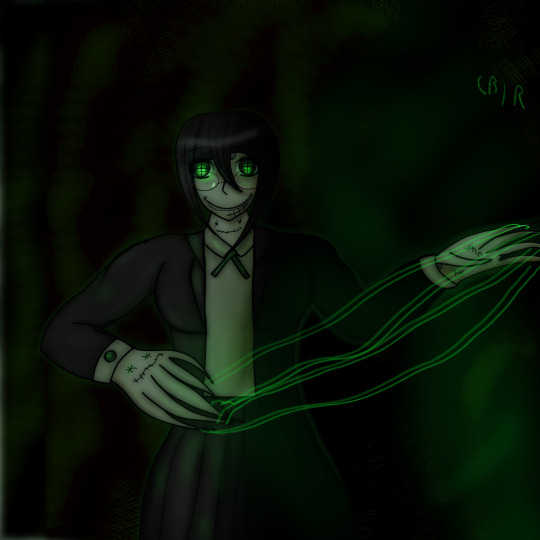
Nui Yoshikane.
Probably my most popular OC, all of you loved Nui. To my surprise too, considering that her character isn't that remarkable. But I am happy you liked her anyway. And because of this, since Nui is officially over a year old, I decided to make this post. To explain the character's creation process and the many changes that they went through.
I hope you'll enjoy it. ^^
Origin
Now, why did I create her? Well, you see a year ago I was planning a new fanfic. One where Tsumugi would wake up after the death and find herself in a non-despair universe with her classmates and herself attending Hope's Peak Academy. With none of them remembering anything from their time of the game.
Given that the story was supposed to be as mind-screwing and ambiguous than the actual V3 game, I knew I needed to add something to distort the truth even further.
And what better way to confuse Tsumugi, is by meeting herself? Or someone that looks oddly familiar to her, in a way.
And that's, how I decided to create the OC who would be in the future known as Nui Yoshikane.
Creation Process
When I created Nui, I was inspired by a certain character from a series that I just got into, around last year. Said series inspired me to write the above aforementioned fic to begin with.
I am talking about the series "Don't Hug Me I'm Scared." And the character I am referring to, is her.
Lesley. (Spoilers below)
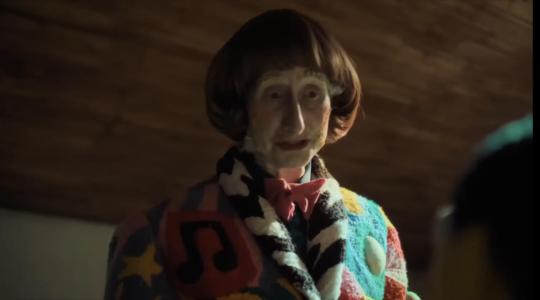
The moment I saw her, I was obsessed with the character for a variety of reasons. One, her demeanor was so oddly comforting and I especially loved that accent of hers (Not sure if it's a British one, considering the actress of the character is welsh. Oh well.)
Either way, when I created Nui, I wanted to go for a similar character concept. Someone who takes Tsumugi's faux kindness up to the max, which would make her even creepier. The stitches on Nui's face are also a reference to Lesley in that regard.
Another inspiration for Nui's character, was the Beldam from Coraline.
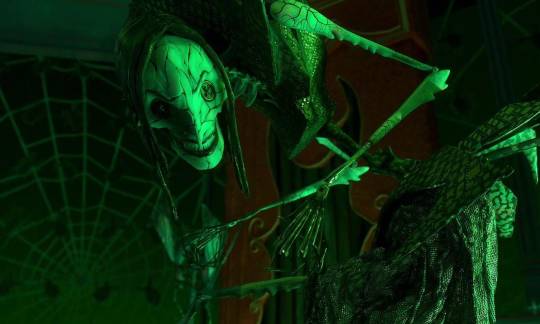
In general, the sewing motif and her status as a seamstress, were inspired by the Beldam in that regard. Her pale skin and darker clothing colors were also inspired by the Beldam, especially her true form as seen above.
Another thing that was inspired by the Beldam regarding Nui's character, where the needle hands. I gave Nui some very thin and long fingers and sharp nails, to give her more of a terrifying look. And to tie in with the sewing motif.
The last character who inspired Nui Yoshikane, is a somewhat surprising choice. But that inspiration was none other than "The Most".
I am talking about Wally Darling.

When I first learned of Welcome Home, Wally Darling stuck to me. His friendly nature and yet his off-putting behavior on the Welcome Home Website instantly made me fall in love with him, as a character.
Due to this, Nui's slow and monotone speech pattern, her curious and almost child-like demeanor. And the general affable demeanor. Of course, since Welcome Home is still ongoing, Wally may develop differently and I am excited to see, how his character will develop.
But I digress. Those were the three main inspirations for Nui's character. Let's go over the design process.
Design
When I designed Nui, my major inspiration was her beta design. In particular this one right here, created by Nona Nightingale.

Her more subdued and darker colors really fit well and I decided to base Nui's design off that beta design. Of course, I couldn't copy it 1 to 1 for obvious reasons, so I went on and tried to work on some different designs for Nui.
And believe me, she went through a lot of changes.
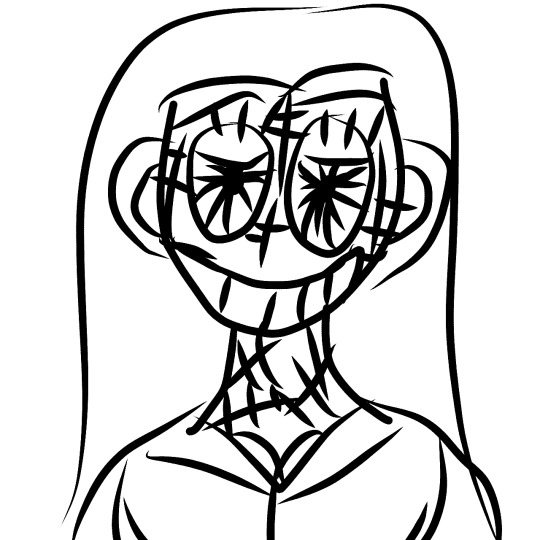
This was one of the first sketches for Nui's character. As you can see, she had a lot more stitches and had a much more disturbing overall appearance. I scrapped the design in the end, because it was just too terrifying and because I wanted Nui to look a bit friendly, if not a tad uncanny. So, I made another sketch.
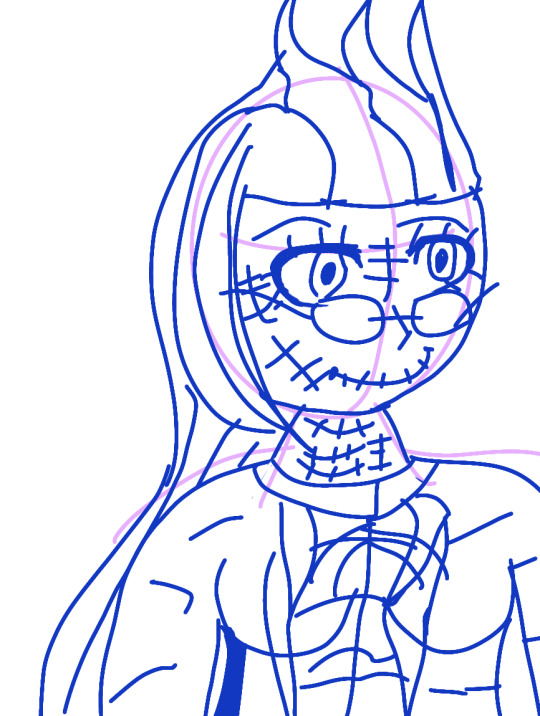
This beta designs, does look a bit more similar to the final product. But again, I was not satisfied with the hair because I wanted to give her a bit more of a sophisticated look. So, I moved on to her first "official" design.
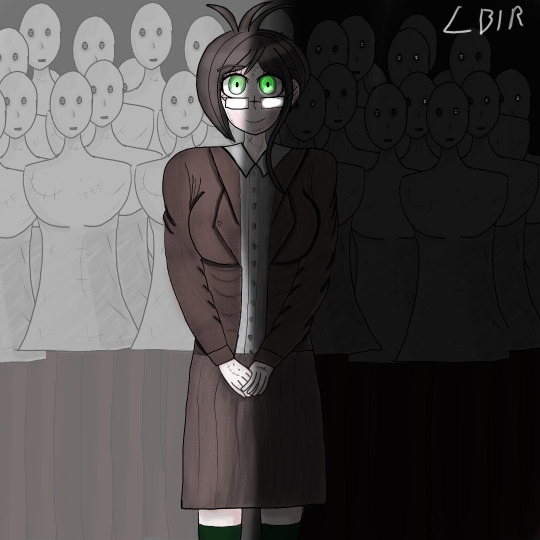
Here's another earlier design of Nui. You can see that unlike the final product, she lacks her green bow tie and her skin is much shorter. Not only that, but the stitches are less noticeable and her overall appearance is a lot less creepy than in the final product. So, I revised yet again.

This design for Nui looks very similar to the final product. As you can see, the stitches are a lot more pronounced and the crossed eyes are vertical and not horizontal, unlike the final version. I was initially happy with Nui's designs, but eventually I gave her a different design yet again.

In this comic that I drew based on the fic where she first appeared in "Welcome To your Paradise", I changed Nui's design a bit more, to reflect her final appearance. However the crosses are still vertical and her blazer is much more lighter, than in the final version.
Now then. This next one was a commission I bought from the lovely @waveglox back in May, I believe. They drew Nui extremely well with a good price and I recommend you, to check their account out. Because they are an incredible artist and a huge inspiration of mine.
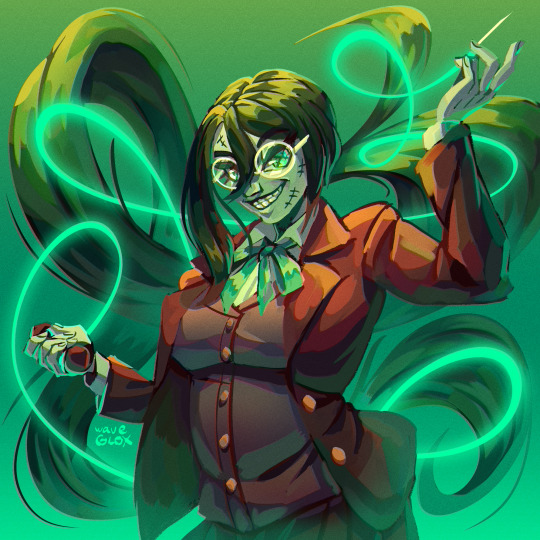
Incredible, isn't it? I jsut love this comission so much and although her hair is a lot longer than in the final version, I am still very happy about it and think her design is absolutely awesome.
But of course, I changed it yet again.
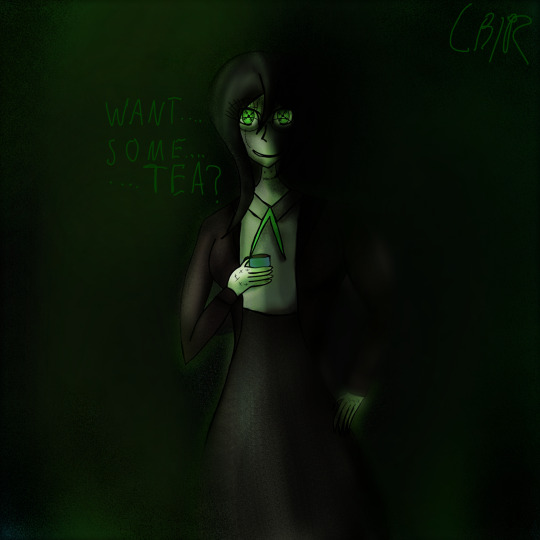
This design looks extremely familiar and simmilar to the final product and the only thing that's different is the overall anatomy and the fact that she looks a lot thinner. But I wasn't satisfied with that design either, so....
This, is her present design
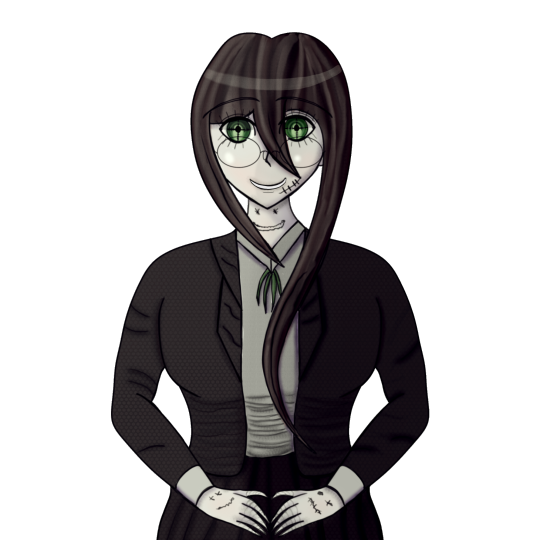
As you can see here, I made the blazer much much darker and I also made the stitches in her eyes horizontal, while giving her a bit of a paler color. And I decided to make the stitches on her neck reflect her current mood. Because, why not?
I am personally happy with the design, since it reflects everything I envisioned about her character. Creepy, yet polite and friendly. However the other versions of Nui's designs, were based on some earlier character concepts of hers. Which leads me to:
Personality and Mannerisms
Originally, Nui was conceived as a pure villainous character. One that would be similar to Junko Enoshima in some aspects, like a faux-affably evil persona and a general manipulative nature. However, as time went on, I decided to flesh her out more. Because I wanted her to be much more complex. Which is why, I added the following.
As I mentioned previously, Nui was inspired by The Beldam from Coraline. In order to differentiate her more from her, I made Nui extremely protective and caring towards children. She would never hurt them and actively hurts those, who harm and endanger children in any malicious way.
Another thing I added, was to make her a bit more dorky. For that, I decided to give her a pianist hobby. But unlike Kaede, Nui's piano skills range from atrocious to just abysmal. Not only that, but I also gave her an affinity for tea. Because Nui's overall appearance was supposed to give off the vibes of a British Lady, sophisticated and polite. To contrast with Junko's hammy and vulgar personality.
Also, when I fleshed her out a bit more, I also gave her a habit of her humming and singing. Something she is a bit better at than playing the piano, but not by much.
The last quirk I added, was that she likes to sew all kinds of stuff. Originally, her specialty was only supposed to be in crafting clothing for dolls, but then I made her more of a general sewing specialist, ranging from fixing clothing and making sweaters among other things.
Other Inspirations
Nui's character is partially based on the concept, of Liminal Spaces. By that I mean, is that she is supposed to give of a familiar and harmless, yet overall strange feeling.
Like...something is off. But you cannot put your finger on it. For this, I even made a Spotify playlist for her, which you can view here.
Lastly, I wanna stress that Nui is not 100% human. What is she really?
You'd love to know that....wouldn't you?
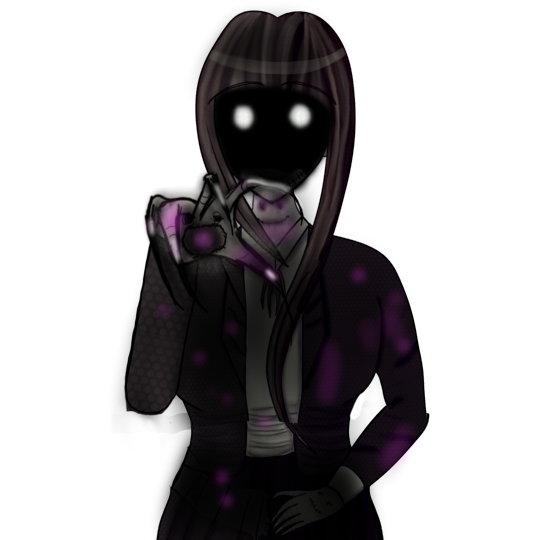
Closing Thoughts
Overall, to say that Nui developed this much over the entire year surprised me. But it does show, how characters can go through a variety of changes, before settling in on their final form. Whether Nui will go through other changes is unknown as of now, but I hope you will stick around.
Lastly, here is some of Nui's voice. Enjoy ^^
Listen.
Thank you for reading and have a good day!
#danganronpa v3#danganronpa killing harmony#danganronpa v3 killing harmony#danganronpa art#danganronpa fanfiction#danganronpa oc#sammylbir#nui yoshikane#danganronpa plasmaverse#plasmaverse
22 notes
·
View notes
Video
Winter robin 2025 London Walks.. by Adam Swaine Via Flickr: A constant presence in our gardens and local green spaces, adult robins are instantly recognisable by their red breast with many tales from folklore of how they acquired their colourful feathers. The red colour features in its scientific name, Erithacus rubecula, and in many languages such as robin goch in Welsh, rouge-gorge in French, and el petirrojo in Spanish.They are a member of the chat family, which also includes species such as stonechat and nightingale.
#Old World flycatcher family#Old World flycatchers and chats#(Old World flycatchers)#robin#robin red breast#robins#Robin (Erithacus rubecula)#adult robin (Erithacus rubecula)#woodland robins#(European) Robin#Birds#little birds#garden birds#nature lovers#nature#natures finest#nature watcher#passerine bird#passerines#perching#wildlife#wild#WINTER#seasons#SE22#South East#beautiful#walks#animals#Adam Swaine
9 notes
·
View notes
Text


Shirley Bassey (1937-) solo Songs: "Goldfinger," "Jezahel" Propaganda: "welsh!" "Those eyes!"
Vera Lynn (1917-2020) solo Songs: "(There'll Be Bluebirds Over) The White Cliffs of Dover," "A Nightingale Sang in Berkeley Square" Propaganda: "Her face and her voice both have character" "She got to be a Dame!! A beautiful voice for longing songs" "Your honour I love her."
Visual Propaganda for Shirley Bassey:




Visual Propaganda for Vera Lynn:






11 notes
·
View notes
Note
Hi Pia!
I was just wondering why you made the Each Uisge Welsh when he’s a figure from Scottish folklore, particularly the Highlands and Islands. I’m from the Isle of Skye, Scotland, and the loch near my home has it’s own each uisge myth attached to it. Even now, parents will tell kids not to go too close to the water or the each uisge might snatch them away. When I was a little kid, I wouldn’t go on the loch on my dad’s boat because my grandpa had terrified me with stories of the each uisge and I’d convinced myself it was real.
Don’t get me wrong, I’m still thrilled to just have an each uisge in fiction, wherever he hails from, and Augus is such an icon.
Ooo it's been years since I've gotten an ask about this.
So yeah, the Each Uisge is Scottish and I actually talked about this a fair bit while I was still actively writing the canon and Augus as a main character (which was I think over 5 years ago now). But it was fully intentional, and ties into the fact that the Each Uisge and Glashtyn shouldn't be sharing a lake at all.
I used to talk about this all the time back when I was still writing the canon. You can see a response to an ask here from 2013 which explains it. And here's some of the relevant info:
Mafydd, like Gwyn, Augus and Ash (in this story - the Glashtyn is usually from Manx and the Each Uisge is usually Scottish, but to make Augus and Ash work as brothers, Augus got uprooted when the lake made a mistake, and now they’re both Welsh) are all Welsh and are all - at this time (at the time of The Drawn Bead) - living in Wales.
This was actually going to be explored in a lot more detail in the fourth installment to the Fae Tales canon, (working title Mirror Realms) where the Nightingale escapes and Gwyn, Augus, and Ash all go down into the underworlds to deal with that, and along the way Augus and Ash meet their mirror counterparts, i.e. the genesis of their fae-realm incarnations, and learn why they were both born into the wrong lake years apart.
But yeah, I think the Raven Prince alludes to this several times as well, that Augus is born in the 'wrong lake' and is an atypical waterhorse because of it.
I'm sure it's in some of the canon side stories but that's a lot of words to ctrl+F through so I'll just leave it as 'oh yeah there's a reason this Each Uisge is so sophisticated and different and has a brother when he shouldn't.' Like, the Glashtyn isn't inherently Welsh either!
It was wholly intentional. I mean if you look closely at all the folklore, it's all messed up - Gwyn's entire family lineage, for example. But Augus and Ash both being born on the fae side of Wales and then both of them being completely fucked up because of it was fully intentional. The Glashtyn doesn't look like that, anon. And the Each Uisge was never supposed to be Gentry Courtier, and yet here we are. :D
#asks and answers#this is one of those 'it's a feature not a bug' lol#fully deliberate#i wanted an atypical glashtyn and each uisge#fae tales verse#fae tales canon#fae tales worldbuilding#folklore and fairytales#every each uisge before this one was born in scotland#and then augus and ash got caught up in an Underworld shitstorm#and ended up somewhere that should have killed them both
15 notes
·
View notes
Text
Delinquent!Gudako Character Info
(Because I realized I haven’t really elaborated enough about her. Also I use Ritsuka and Gudako interchangeably but you get the gist it’s the same person)
She’s half Japanese/half Welsh. The Welsh part comes from her Father’s side of the family. Ritsuka never bothered learning Welsh before coming to Chaldea because the bad association with her absent deadbeat dad. But after some convincing, she picked up some of the language from the Knight of the Round Table (Mostly from Bedivere)
As for her mother, Ritsuka doesn’t remember much about her before she died. 1) because she was so young at the time. 2) because she almost doesn’t want to remember the only other person from family that loved her knowing she’s already gone.
Boxing is her preferred form of fighting, but the training she got from Scathach, Beowulf, and Leonidas made her more adept at Mixed Martial Arts.
Will NEVER admit that she has a massive inferiority complex about her magic circuits being kinda crappy compared to everyone else. It’s another big reason she trains as much as she does. Overcompensating for something beyond her control.
I think I mentioned before but, a massive reason why she’s so dense is because of her low self-worth. Aside from her Grandpa, there wasn’t anyone else that was willingly to give her the time of day either because they feared her or hated her. She didn’t have other people she could call friends and most people would avoid her. So the concept of anyone might be attracted to her is baffling.
That entire event in Shimousa involving Shuten really fucked with her head for a good two weeks. Waking up in the middle night, phantom pains on her abs, feeling like she’s about to vomit blood when she wasn’t. No one else aside from Musashi, Kotaru, and Dantes knew what had happened because she begged them not to speak of it. Eventually Nightingale and everyone found out about it after they pressed her for questions.
Ritsuka is still human in this AU. It’s just there are certain oddities about her that would make people second guess it. She can see in the dark without her eyes having to adjust, she’s alot more durable than most humans even before the training, and her inhuman appetite. Little things like that make you think something about her is…off
When I mean inhuman appetite, Ritsuka can eat about 2/3 of Barghest’s Valentines Day gift. ON. HER. OWN. Baffling to both Chaldea Kitchen Staff and Saberfaces alike.
A big part of why this version of Gudako is compatiable with so many servants isn’t just because she’s an average human. She’s an average human who had to learn how to empathize fast ever since Singularity F. She didn’t care about other people that wasn’t her Grandfather until she met Mash. So learning she was capable of even that small bit of empathy was new to her and something she had to work on.
Ritsuka use to hate maguses. Especially towards those that work at the Clock Tower. It’s only after she got to meet people like Olga, Romani, and Waver that had her think maybe all maguses aren’t completely awful people.
She learned Mandarin and Cantonese ���just she so could cuss out Yu Mei-Ren in her language. Same thing with Jalter and learning French because Ritsuka is that petty
Ritsuka actively tries to not cuss in front of child servants since she thinks it would set a bad example for them.
You can’t debate her with about G Gundam NOT being the best series because she will give you a 10 page paper on why you’re wrong.
She’s actually self-conscious about the scar on face. Not because of how it looks (although it doesn’t help), but because it’s a reminder of how powerless she was when it happened.
Thick Thigh Enthusiast until the day she dies
She is very much a Shembo (She-Himbo)
Closeted Love Live! School Idol Project fan. Liz and Osakabehime are the only other people that know about this.
If this Ritsuka was ever a servant, she would be either a Rider or a Berserker.
Gudako has a habit of repressing all of her trauma, anger, and anxieties because her everyone still needs her and dealing with it is a hassle. This will have consequences later…
Despite being a delinquent, Gudako still has a code of conduct thanks to Grandpa Fujimaru. Mostly her being against fighting the kids and the elderly even if they are servants.
Anyway that’s all I can think of right now.
#there’s probably more#this is all i could think of#fate grand order#fgo#ritsuka fujimaru#delinquent gudako au#gudako#female ritsuka fujimaru
40 notes
·
View notes
Text

In 1967 when Radio 1 was founded as a successor to the BBC Light Programme, one of its aims was to reach housewives – and to attract them, the station employed only male DJs (or “husband substitutes”, as they were known behind the scenes) for the first three years. It was only in 1970, bending with the times, that it took on its first female presenter, Anne (later Annie) Nightingale, a former journalist and television presenter with almost no radio experience.
The original male presenters have long since left the station, but Nightingale was still working for Radio 1 at the time of her death, aged 83, and had become its longest-serving broadcaster, most recently on air in December 2023. Known to fans as the Queen of Breaks – breakbeat was her specialist genre – she defied the station’s usual career trajectory (five years as a top-tier presenter, then off to weekends or Radio 2) by staying relevant. She introduced listeners to prog rock, punk, indie and dance music, and was unfeignedly passionate about them all. At 75, she told a dance magazine: “I listen to what 13-year-olds listen to because that’s the future. [I’ve] got to be ahead of the game all the time.”
As a dance music specialist from the late 1980s onward – playing “the biggest bass bangers”, as Radio 1’s website put it – Nightingale spent the second half of her career broadcasting to people too young to have known that she had been friends with the Beatles and Marc Bolan. But her age was immaterial because of her stature in the dance world. In 2001, she received Muzik magazine’s Caner of the Year prize in recognition of her late-night lifestyle – her favourite of all her awards, which also included an MBE in 2002 for services to broadcasting (advanced to CBE in 2020), and an honorary doctorate in journalism.
She was a highly knowledgable musical curator, and an expert at exploiting the intimacy of radio. Though Nightingale prioritised music over DJ patter, she recognised that a human voice was still an essential part of the mix; husky-toned and self-deprecating, she belied the station’s early fear that a female DJ would lack authority. According to the writer Irvine Welsh, who listened to her while growing up, her “cool, funky tones” stood out against “the flatulent sounds of loud, boring, thick and egotistical men strafing the airwaves”.
An only child, Nightingale was born in Osterley, west London, to Basil, who ran a wallpaper company, and Celia (nee Winter), a chiropodist. Educated at the independent Lady Eleanor Holles school in Hampton, she left before her A-levels. Overriding her parents’ request that she have “something to fall back on”, she enrolled on a journalism course at the Regent Street Polytechnic (now the University of Westminster). Moving to Brighton after graduation, she married a Fleet Street journalist, Gordon Thomas, and had two children. After a short stint at the Brighton and Hove Gazette, she became the only woman in the newsroom at the Brighton Argus.
Along with reporting local news at the parish-council level, she was given a music column called Spin With Me, which gave her access to the biggest pop stars of the 60s. Her friendship with the Beatles later helped open doors at Radio 1 – the band’s publicist, Derek Taylor, persuaded the station controller to let her audition after her own requests were repeatedly refused.
At a Dusty Springfield gig in 1964, she met Vicki Wickham, producer of Ready Steady Go!, who hired her as co-presenter of a new pop show called That’s For Me. It lasted only a few months, but the exposure led to writing work at the Daily Express and Cosmopolitan, and radio appearances on Today and Woman’s Hour. It was the era of pirate stations such as Radio Caroline; she considered applying to Caroline but was put off by the idea of “living out at sea with a bunch of blokes”.
Finally installed at Radio 1 in 1970, she was hampered at first by a lack of technical knowhow – her first day was marked by eight seconds of dead airtime when she accidentally pressed the “off” switch in the middle of a record. Yet she quickly established herself, choosing her own playlist almost from the start. Her skill at persuading listeners that what she wanted to hear was what they wanted to hear led in 1978 to the job of presenting BBC Two’s “serious” rock programme, The Old Grey Whistle Test. It had failed to keep up with musical fashion, a problem she tackled by booking the most challenging artists she could get away with and braving the consequences. She was delighted to bag Public Image Ltd for a live appearance, though frontman John Lydon repaid her enthusiasm by admonishing her for being “so fucking patronising”.
Four years at Whistle Test were followed by a return to Radio 1’s highly popular Sunday afternoon request show for 12 years. When acid house gained traction in the late 80s, she credited it with changing her life; from that point, she played solely dance music on Radio 1, first in the influential Chill Out Zone slot, then on a longstanding programme that went out at 1am on Wednesdays. Her free time, she said, was consumed by listening to the thousands of demo tapes she received every week.
Despite her achievements, Nightingale claimed she lacked confidence until she was robbed in Havana, Cuba in 1996. The attack left her unable to walk for months, but made her “a stronger person”, she said.
Though she hated nostalgia, she did reflect that ageing had been isolating. The death of John Peel, her friend from the early days of Radio 1, provoked the unusually downbeat comment: “Now John’s gone there’s nobody I know in my age group who remotely likes this kind of thing. I don’t understand why. I’m driven by it.”
She published two volumes of autobiography, Chase the Fade (1982) and Wicked Speed (2000), and a 50th-anniversary volume, Hey Hi Hello: Five Decades of Pop Culture from Britain’s First Female DJ, in 2020.
She is survived by her children, Alex and Lucy, from her first marriage, which ended in divorce. Her second marriage, to the actor Binky Baker in 1978, also ended in divorce.
🔔 Anne Avril Nightingale, broadcaster, born 1 April 1940; died 11 January 2024
Daily inspiration. Discover more photos at Just for Books…?
16 notes
·
View notes
Text


brūcan (Old English), vb. 2, w. gen. object, make use of, enjoy, derivatives: break, broken

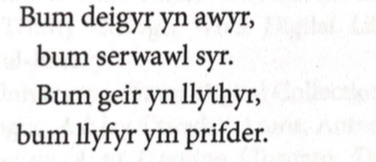

tissue (Modern English), noun use of tissu "woven, interlaced," past participle of tistre "to weave," from Latin texere "to weave, to make," from PIE root *teks- "to weave," also "to fabricate."


As kingfishers catch fire, as dragonflies draw flame, / as tumbled over rim in roundy wells / Stones ring, like each tucked string tells, each hung bell's / Bow swung finds tongue to fling out broad its name...


"Butterflies emerged around the same time as flowering plants. Throughout their long history they have diversified and developed amazing adaptations like powerful poisons, silk thread, stationary flight, transparent materials, temperature regulation, astonishing colors and patterns, and defenses against bacterial infections.
They have so much to teach us."

Shall we begin by taking it as a general principle--that all disease, at some period or other of its course, is more or less a reparative process, not necessarily accompanied with suffering: an effort of nature to remedy a process of poisoning or of decay, which has taken place weeks, months, sometimes years beforehand, unnoticed, the termination of the disease being then, while the antecedent process was going on, determined?

MATERIALITY: "Time and Other" by Levinas / glossary entry: "brūcan" / NIH entry: gold (Au) / welsh verse Kat Godeu, Battle of the Trees / etymology of "tissue" (biological) / Medieval Medicine, edited by Faith Wallis / "Finishing the Hat," Sondheim / Gerard Manley Hopkins / wikipedia entry / Nietzche's "Rhythmic Investigations" / NOVA documentary on butterfly morphology / Donna Haraway, Staying with the Trouble / Florence Nightingale / article on using sugar-based products to replace single-use plastics
8 notes
·
View notes
Text
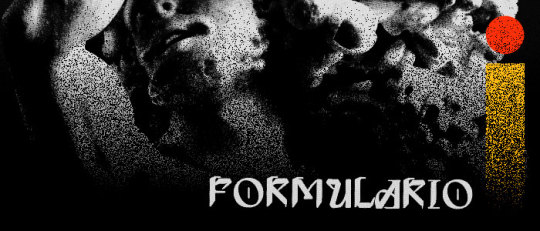
🗡Luces resplandecen a través de los ventanales de imponentes arquitecturas, la naturaleza oscura reclama los lugares olvidados y la metrópolis parece rugir cada noche con más fuerza. ¿Has decidido en donde esperarás el final de los tiempos? La multitud de figuras en las sombras te guían hacia el Palacio Imperial, tierra prometida en donde el Príncipe de la Camarilla se complace en recibirte. A pesar de tu extraño parecido a TOM STURRIDGE y ser parte de los TOREADOR, eres más que bienvenido a la ciudad RYAN WELSH. Si las consecuencias no quieres pagar, deberás respetar cada una de las tradiciones y cuidar siempre tu espalda...
PSYCHE, la administración de Tierra de Nod se alegra de darte la bienvenida. A partir de este momento cuentas con 24 horas para realizar el envío de la cuenta de tu personaje. Cualquier consulta estamos a tu disposición. ¡Muchas gracias!
OOC
Nombre / Pseudónimo — Psyche Pronombres — ella/elle Edad — 32 Zona horaria / País — Chile -4 GMT Triggers — Nada que venga a la mente en este momento ¿Estás de acuerdo que tu personaje continúe siendo utilizado por la administración como PNJ en caso de unfollow? — No, pero pueden matarlo si lo desean. IC
Nombre — Ryan Welsh, conocido en el mundo artístico como Morpheus Nightingale
Faceclaim — Tom Sturridge
Pronombres — Él/Elle
Nacionalidad — Británico
Fecha de nacimiento — 7 de enero de 1950
Año en el que se convirtió en vampiro — 1981
Generación asignada — Decimotercera
Clan y secta — Cupo 4, clan toreador, parte de la Camarilla
Detallar el nivel que posee en cada disciplina — auspex +2 celeridad +2 presencia 0
Personalidad—
sensible. pacífico. soñador.
susceptible a la crítica. pasivo. desconectado de la realidad
¿Quiénes eran antes de ser vampiros y qué mantienen de su antigua vida? — Nacido en Londres, en de una familia de aristócratas en decadencia, Ryan es menor de tres hermanos y el único que jamás estuvo interesado en mantener el prestigio de su nombre. Su padre era hombre simple, un corredor de propiedades interesado sólo en el dinero y el estatus que el nombre de su mujer podía darle, pero su madre era toda una artista, una cantante de ópera que debido a problemas de salud había visto su carrera terminada tempranamente. Por su parte, Ryan debió ser educado en casa, debido a que padecía hemofilia y cualquier corte o golpe podía terminar en una hemorragia fatal. A pesar de que la enfermedad retrasó el desarrollo de sus habilidades sociales le abrió un mundo de posibilidades que lo llevó a desarrollar gran potencial artístico, así como también un profundo interés por la mente humana y la psicología. Devoraba tanto libros sobre historia del arte como nuevos postulados sobre el inconsciente. Creía fervientemente que existía un vínculo sanador entre las emociones y el quehacer artístico y planeaba estudiar psicología para demostrarlo, pero la fragilidad de su cuerpo le provocó un intenso miedo de salir de su casa, en cual se vio incluso más acrecentado con la temprana muerte de su madre. Recluido de la sociedad e intentando superar el duelo, Ryan volcó su vida a mejorar su arte. Pintó primero a su madre, para no olvidar su rostro, luego a sus hermanos, a las esposas de los mismos, a sus sobrinos. Las pinturas comenzaron a ganar interés dentro de los círculos que su familia frecuentaba. Comenzó a tener pedidos especiales: duques, condes y celebridades se sentaron en su estudio para ser inmortalizados. Su padre lo vio como un negocio rentable y por casi diez años pintó retratos en óleo que buscaban ser copia exaltada de la realidad, la forma en la que la gente quería verse a sí misma. Ganó mucho dinero, pero a medida que pasaban los años, sus pinturas comenzaron a volverse cada vez más simbólicas, buscando capturar el alma de la persona, su esencia. Volvió al inicio, entrando en un estado de trance al pintar, dejó que su mente inconsciente guiara su mano. Pintó a su madre nuevamente, no como la mostraban las fotos sino como él la recordaba, como la había sentido en vida. El resultado fue impresionante. Su padre lloró al verla, sus hermanos y sobrinos conversaban con el cuadro como si fuese una persona real… Las habladurías sobre la pintura llegaron a otros círculos, aquellos que se movían en el Ocultismo, muchos llegaron a pensar que el joven había atrapado el alma de su difunta madre en el cuadro, pero nadie pudo probar nada. Fue allí que el primer ser de la noche tocó a su puerta. Resultó ser una recién nacida de Lasombra que, aún buscando una forma de verse a sí misma tras su conversión, pidió ser retratada como él la veía. El resultado fue nuevamente sorprendente. La joven, hermosa y adorable, no tenía nada que ver con el seductor monstruo en la pintura. La cara era la misma, sin lugar a dudas, pero la mirada fría y la sangre en su ropa la hacían ver como una asesina, sonriente ante la idea de terminar con su próxima víctima. Ryan no sabía qué hacer, había dejado que su inconsciente le mostrara la realidad y eso había hecho. Su clienta no pareció molestarse e incluso agradeció su sinceridad… Pronto, ella se convirtió sólo en la primera de muchos vástagos capturados por su método poco ortodoxo de pintar.
¿Qué sabe sobre quien los convirtió en vampiros? — Su conversión fue una cosa que se salió de control. Quién lo mató fue una de las muchas personas que quisieron ser retratadas por él pero luego que Ryan le mostrara su verdadero rostro, lleno de codicia y odio, el vástago se molestó y terminó mordiéndolo. Agonizó durante días por la herida en su cuello, la cual se cerraba y se abría nuevamente debido a su hemofilia. Tras una semana de tormento, sin embargo, una de sus primeras modelos, una vástago toreador que admiraba su talento le ofreció la oportunidad de convertirse en inmortal, la cual aceptó inmediatamente. En el abrazo, Ryan encontró la libertad que siempre había ansiado, sin miedo a la muerte se convirtió en un viajero incansable que no para en un solo lugar por mucho tiempo.
Curiosidades —
La mayor parte de su trabajo temprano ha sido confiscado por la Camarilla pues en muchos casos es notorio que sus modelos no eran humanos. Una vez que se dió cuenta que este tipo de arte jamás llegaría a las masas, dejó de pintar y esculpir rostros a menos de que se lo pidan explícitamente. Para evitar mayor escrutinio por parte de la Camarilla de Londres se mueve constantemente por el mundo, aún sigue publicando su arte en internet, bajo distintos seudónimos, pero hoy en día ha dejado mayoritariamente de lado los retratos y se dedica a retratar el cielo nocturno en todo su esplendor. Es un Sandman, sólo bebe de personas dormidas, pues una parte de él cree que la sangre de una persona conectada a su inconsciente le entrega mayor inspiración.
3 notes
·
View notes
Photo

Ben Schnetzer in Pride (Matthew Warchus, 2014)
Cast: Ben Schnetzer, Joseph Gilgun, George MacKay, Faye Marsay, Dominic West, Andrew Scott, Imelda Staunton, Bill Nighy, Russell Tovey. Screenplay: Stephen Beresford. Cinematography: Tat Radcliffe. Production design: Simon Bowles. Film editing: Melanie Oliver. Music: Christopher Nightingale.
The success of The Full Monty (Peter Cattaneo, 1997), a movie about unemployed steelworkers who become male strippers, seems to have inspired a new genre of feel-good movies about the struggles of the British working class. And Margaret Thatcher's union-breaking efforts during the 1984 coal-miners' strike has become the nexus for a series of films in the same spirit. The year before The Full Monty, there was Brassed Off (Mark Herman, 1996), about how the brass band staffed by unemployed coal miners helped raise spirits after their pit was closed. There was Billy Elliot (Stephen Daldry, 2000), about a striking miner's son who wants to become a ballet dancer. Like The Full Monty, it became a hit stage musical. Unfortunately, once you have a string of movies like these, you also have a formula to follow, which Stephen Beresford's screenplay for Pride, in which a group of gays and lesbians in London decide to raise funds to support striking Welsh miners, does almost to the letter. It's based on a true story, and the results are amusing and heart-warming, but a feeling of déjà vu works to prevent your feeling that you've seen anything fresh and surprising. What it has going for it is a beautifully committed cast, with some familiar old pros -- Bill Nighy, Imelda Staunton, Andrew Scott, and Dominic West -- and a few fine newcomers, particularly Ben Schnetzer, an American actor who launched his career in Britain. (An interesting reversal, considering the number of Brits, including West in The Wire and The Affair, along with Andrew Lincoln in The Walking Dead, Matthew Rhys in The Americans, and Hugh Dancy in Hannibal, who have found their careers flourishing in American television.) The film capitalizes on anti-Thatcher sentiments while downplaying the contemporaneous arrival of the AIDS crisis. There is a scene in which the group's leader, Mark Ashton (Schnetzer), encounters a former lover (a cameo by Russell Tovey) who is obviously ill, and a revelation that Jonathan Blake (West) was diagnosed with the disease several years earlier, but these are incidental to the main plot. The movie manages to avoid spoiling the feel-good mood by revealing only in the credits sequence that Ashton died at the age of 26 in 1987; Blake, however, is still alive.
3 notes
·
View notes
Text
What Happened on September 14 in British History?
September 14 has been a date of pivotal moments in British history, encompassing international diplomacy, wartime strategies, educational milestones, cultural achievements, and royal commemorations. From treaties with the Dutch to the opening of modern landmarks, these events reflect the nation’s evolving global influence, military engagements, and cultural legacy. In this article, we explore key historical events that took place on September 14.

What Happened on September 14 in British History?
Netherlands and England Sign Peace Treaty (1662)
On September 14, 1662, the Netherlands and England signed a peace treaty aimed at resolving ongoing disputes between the two maritime powers. The relationship between the Dutch Republic and England had been fraught with tension due to competition over trade routes and colonial expansion. This treaty sought to de-escalate hostilities following the First Anglo-Dutch War (1652–1654), during which both nations vied for control of lucrative global markets.
Although the treaty of September 14 momentarily restored peace, the rivalry between the two nations continued, leading to further conflicts in subsequent decades. The treaty is significant as part of the broader narrative of 17th-century European geopolitics, where maritime nations struggled for dominance in overseas trade. The Anglo-Dutch Wars profoundly shaped Britain’s approach to naval power and trade, helping to pave the way for the later rise of the British Empire.
Bishop Gore School Founded (1682)
On September 14, 1682, Bishop Gore School, one of the oldest educational institutions in Wales, was founded. Located in Swansea, the school was originally established as a grammar school to provide education to boys. It was named after Bishop Hugh Gore, who played a significant role in founding the institution, envisioning it as a place to nurture young minds and instill a strong Christian education.
Throughout its long history, Bishop Gore School has undergone significant changes, including evolving into a co-educational institution and expanding its curriculum. The school’s founding on September 14 highlights the long tradition of formal education in Britain, contributing to the development of intellectual and civic leaders who have shaped Welsh and British society.
Handel Completes “Messiah” (1741)
On September 14, 1741, George Frideric Handel completed his monumental oratorio Messiah, one of the most famous works in Western classical music. Handel reportedly worked non-stop for 23 days to finish the composition, which was designed to tell the story of Christ’s birth, death, and resurrection. Although initially written for Easter performances, Messiah has become a staple of the Christmas season in Britain and around the world.
Handel’s completion of Messiah on September 14 marked the beginning of a journey that would see the oratorio gain immense popularity, first in London and later internationally. Its inclusion in British cultural heritage cannot be overstated; performances of Messiah have been a part of British life for centuries, influencing the nation’s musical traditions and cultural identity.
British Forces Land at Calamita Bay (1854)
On September 14, 1854, British and French forces landed at Calamita Bay on the Crimean Peninsula as part of the Crimean War (1853–1856). The war, which saw the British Empire, France, and the Ottoman Empire join forces against the Russian Empire, was sparked by disputes over influence in the Middle East and protection of Christian minorities in the Ottoman Empire. The Crimean War is widely remembered for its brutal conditions and the pioneering work of figures such as Florence Nightingale.
The landing on September 14 marked a critical stage in the Crimean campaign, as British and French troops aimed to besiege the Russian stronghold of Sevastopol. The Crimean War holds an important place in British military history, not only for its strategic significance but also for the way it reshaped public perceptions of war, with the advent of war reporting and significant reforms in military healthcare.
“Your Country Needs You” Poster (1914)
On September 14, 1914, the now-iconic “Your Country Needs You” poster featuring Lord Kitchener appeared on the front cover of the London Opinion magazine. This poster, which depicts the stern face of Kitchener pointing directly at the viewer, became a powerful recruitment tool during the early stages of World War I. It called on British men to enlist in the army and serve their country in the fight against the Central Powers.
The use of Kitchener’s image on September 14 had a profound impact on the British public. The poster is remembered as one of the most effective pieces of wartime propaganda, successfully encouraging thousands of men to join the war effort. Today, it remains a symbol of British patriotism and the sacrifices made by those who fought in the Great War.
Churchill Visits Scapa Flow (1939)
On September 14, 1939, Winston Churchill, then First Lord of the Admiralty, visited the British naval base at Scapa Flow in the Orkney Islands. The visit came just weeks after the outbreak of World War II, as Britain prepared for what would become a long and grueling conflict. Scapa Flow, with its strategic location and natural harbor, served as a key base for the Royal Navy during both World Wars, protecting Britain from naval threats, particularly from German U-boats.
Churchill’s visit on September 14 emphasized the critical importance of Scapa Flow to Britain’s war strategy. His presence at the naval base signaled the government’s commitment to securing British waters and maintaining naval dominance. The visit also foreshadowed Churchill’s rise to Prime Minister in 1940, a role in which he would guide Britain through its darkest and most victorious hours of World War II.
British Soldiers Killed in Northern Ireland (1971)
On September 14, 1971, two British soldiers were killed in separate shooting incidents in County Tyrone, Northern Ireland. This marked yet another tragic day in the ongoing conflict known as “The Troubles,” a violent period of sectarian strife that lasted from the late 1960s to the 1998 Good Friday Agreement. The soldiers’ deaths on September 14 were part of a larger pattern of violence involving paramilitary groups, such as the Irish Republican Army (IRA), and British forces.
The incidents on September 14 highlighted the dangers faced by British soldiers and civilians alike during The Troubles. The period remains one of the darkest chapters in modern British history, with over 3,500 people killed in the conflict. Efforts to bring about peace and reconciliation continue to this day, with September 14 serving as a reminder of the toll that political and sectarian violence took on the United Kingdom.
Provisional IRA Bombing Campaign (1978)
Beginning on September 14, 1978, the Provisional Irish Republican Army (IRA) launched a five-day bombing campaign across Northern Ireland, detonating more than 50 bombs in towns across the region. The attacks injured 37 people and caused widespread fear and panic. The bombings were part of the IRA’s broader campaign to end British rule in Northern Ireland and bring about the unification of Ireland.
The bombing campaign starting on September 14 was just one of many violent actions taken by the IRA during The Troubles. The attacks underscored the ongoing tensions in Northern Ireland and the challenges faced by the British government in maintaining order and security. The legacy of these attacks remains a painful chapter in Northern Ireland’s history, though the peace process has made significant strides in the decades since.
Darwin Centre Opens at the Natural History Museum (2009)
On September 14, 2009, the Darwin Centre at the Natural History Museum in London was officially opened by Sir David Attenborough and Prince William. This marked the most significant expansion of the museum since 1881, and the centre was designed to house the museum’s vast collections of insects and plants, as well as provide state-of-the-art research facilities for scientists.
The opening of the Darwin Centre on September 14 represented a major milestone in British scientific research and education. Named after Charles Darwin, the centre reinforces Britain’s long-standing commitment to biological research and the natural sciences. It also underscores the Natural History Museum’s role as a global leader in scientific discovery, attracting millions of visitors and fostering greater understanding of biodiversity and conservation.
Procession of Queen Elizabeth II’s Coffin (2022)
On September 14, 2022, a solemn procession took place in London as Queen Elizabeth II’s coffin was moved from Buckingham Palace to the Palace of Westminster to lie in state. Thousands of mourners lined the streets to pay their respects, and a queue of people waiting to see the Queen stretched for 2.4 miles. The procession marked a poignant moment in British history as the nation prepared to bid farewell to its longest-reigning monarch.
The events of September 14 during the Queen’s funeral proceedings were a reflection of the deep respect and affection held by the British public for Queen Elizabeth II. Her reign, which spanned over seven decades, had an immense impact on both Britain and the wider world. The procession and subsequent lying-in-state symbolized the end of an era and the continuity of the British monarchy.
Conclusion
September 14 in British history encompasses a wide array of events, from cultural achievements like Handel’s Messiah to significant military actions during the Crimean War and World War II. This date has also seen moments of political and social upheaval, such as the violence during The Troubles and the leadership of Winston Churchill during wartime. As these events demonstrate, September 14 is a date that has left its mark on Britain’s history, shaping the nation’s cultural, political, and military legacy.
0 notes
Text



―――――― ryan welsh . inglés . 1950 - 1981 . aparenta edad de 30 a 32 años . artista plástico conocido como morpheus nightingale . él/elle . clan toreador de la camarilla .

main . biografía . memes . espejo . + MORE
drafts : 0 asks : 0
1 note
·
View note
Photo


‘Landladies’: photos of Margiad Evans (Peggy Whistler), the bisexual Anglo Welsh writer. Left: With sister Nancy Whistler/Sian Evans at Ross on Wye in 1938. Right: Margiad at Springherne, near Ross on Wye in the last 1930s.
Via ‘Women in Trousers’, an Archive by Cardiff University. (Women in Trousers on Twitter)
#margiad evans#history#welsh history#women in trousers#lgbt history#women's history#queer history#welsh queer history#nancy whistler#the whole archive is not lgbt history but is an interesting archive#with photos from Wales as well as an archive of photos from all over with sources#photography#via Nancy Nightingale's collection#I shall post more about margiad evans another time but see previous Welsh post I reblogged which I also wrote~#margiad evans 1909-1958#bisexual history#welsh literature#by m
23 notes
·
View notes
Photo

They spoke no more of the small news of the Shire far away, nor of the dark shadows and perils that encompassed them, but of the fair things they had seen in the world together, of the Elves, of the stars, of trees, and the gentle fall of the bright year in the woods.
#original photography#nature photography#Campanula rotundifolia#harebell#clychau'r eos#Wales#wildflower#botany#nature#flower#the Welsh name means the nightingale's bells#enjoy the little things
8 notes
·
View notes
Text

Clive Hicks-Jenkins (Welsh, 1951) - Illustration for The Owl & The Nightingale (2020)
492 notes
·
View notes
